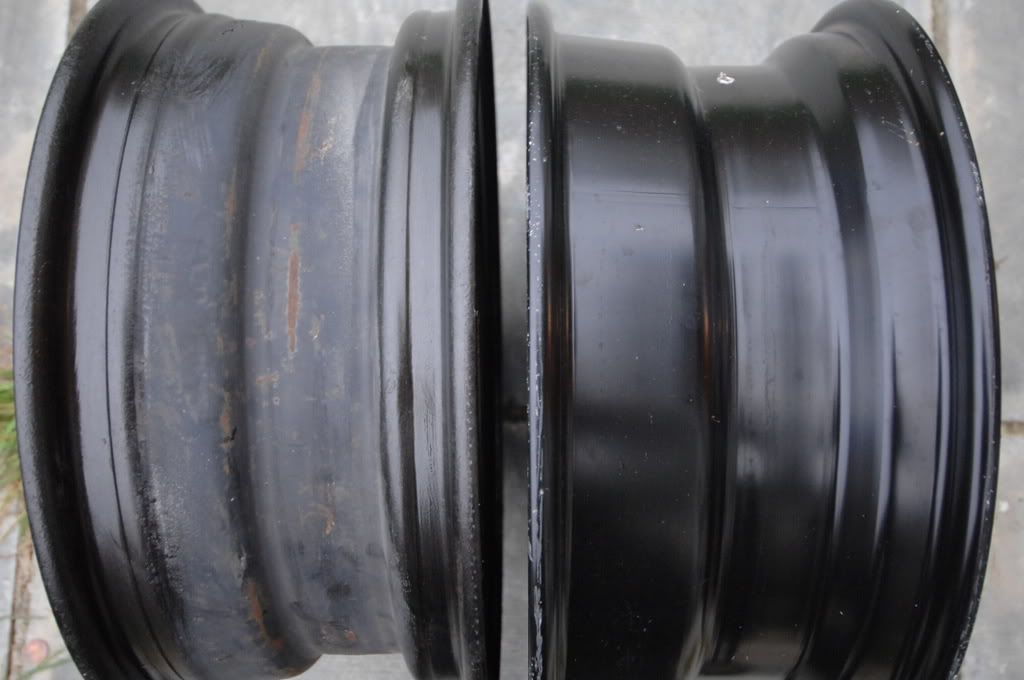Station House
Well-Known Member
- Posts
- 3,960
- Location
- Fife, Scotland
Don't know if this is of any use to anyone, but I needed to know when changing my wheels last week and searching for the answer took a fair while. I learnt more about the subject than I ever felt I needed to!
Here is how to identify a tubed and tubeless rim - the main difference is that the tubeless one (on the left) has a defined bead seat, where as the tubed one does not:

Whilst I am at it, some tips around mixing tubes and tubeless with each other.
There are of course several permutations - you can have either tube type tyres or tubeless type tyres, likewise tubed or tubeless rims.
Tubeless rims should all have the inner retaining hump to hold the bead in place; if they do not have this you should not fit tyres to these rims tubeless. Tube type rims generally do not have this hump.
Tubeless tyres often have a rough or ribbed inside to the carcass which will wear out a tube if fitted. Tube type tyres will generally be better finished inside.
So the options are:
1) Tube type tyre on tube type rim with a tube – OK
2) Tube type tyre on tube type rim fitted tubeless - NOT OK – it can leak around the bead and the bead is not retained safely so may pop off on cornering
3) Tubeless tyre on a tube type rim with a tube - OK, but be aware of possible tube chafing depending on the finish of the tyre interior
4) Tubeless tyre on a tube type rim fitted tubeless - not OK
5) Tube type tyre on a tubeless rim fitted with a tube – best avoided - the tube gets distorted by the second hump on the rim and can fail
6) Tube type tyre on a tubeless rim fitted tubeless - not OK - the bead on tubed tyres is not designed to seal particularly well so can leak
7) Tubeless tyre on a tubeless rim fitted tubeless - OK – the most common for modern vehicles
8) Tubeless tyre on a tubeless rim fitted with a tube – best avoided – the tube gets distorted by the second hump on the rim and can fail
Most original Defender steel wheels are tube type only, whereas most other rims (Discovery steels, 8 spokes, alloys etc) are tubeless.
Finally worth being aware of the two valve sizes (again I wasn’t before last week!). Most tubeless rims have a TR13 valve hole whereas original Defender steels have a TR15 valve hole. The TR15 is a larger diameter more often found on agricultural vehicles.
Hope that helps someone.
Here is how to identify a tubed and tubeless rim - the main difference is that the tubeless one (on the left) has a defined bead seat, where as the tubed one does not:
Whilst I am at it, some tips around mixing tubes and tubeless with each other.
There are of course several permutations - you can have either tube type tyres or tubeless type tyres, likewise tubed or tubeless rims.
Tubeless rims should all have the inner retaining hump to hold the bead in place; if they do not have this you should not fit tyres to these rims tubeless. Tube type rims generally do not have this hump.
Tubeless tyres often have a rough or ribbed inside to the carcass which will wear out a tube if fitted. Tube type tyres will generally be better finished inside.
So the options are:
1) Tube type tyre on tube type rim with a tube – OK
2) Tube type tyre on tube type rim fitted tubeless - NOT OK – it can leak around the bead and the bead is not retained safely so may pop off on cornering
3) Tubeless tyre on a tube type rim with a tube - OK, but be aware of possible tube chafing depending on the finish of the tyre interior
4) Tubeless tyre on a tube type rim fitted tubeless - not OK
5) Tube type tyre on a tubeless rim fitted with a tube – best avoided - the tube gets distorted by the second hump on the rim and can fail
6) Tube type tyre on a tubeless rim fitted tubeless - not OK - the bead on tubed tyres is not designed to seal particularly well so can leak
7) Tubeless tyre on a tubeless rim fitted tubeless - OK – the most common for modern vehicles
8) Tubeless tyre on a tubeless rim fitted with a tube – best avoided – the tube gets distorted by the second hump on the rim and can fail
Most original Defender steel wheels are tube type only, whereas most other rims (Discovery steels, 8 spokes, alloys etc) are tubeless.
Finally worth being aware of the two valve sizes (again I wasn’t before last week!). Most tubeless rims have a TR13 valve hole whereas original Defender steels have a TR15 valve hole. The TR15 is a larger diameter more often found on agricultural vehicles.
Hope that helps someone.
Attachments
Last edited:

